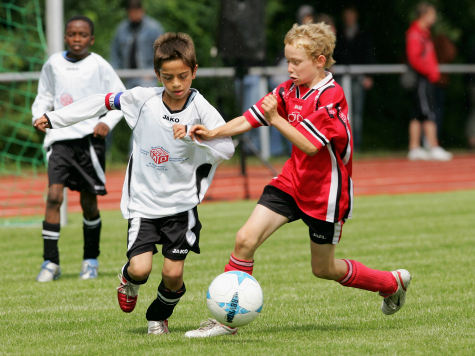The concussion crusaders who have attacked American football now set their sights on European football. When does the ban come on “duck, duck, goose” head patting?
Association football, a phrase that degenerated into “soccer,” shares a name, eleven players to a side, and a crossbar with American football. It doesn’t share much else. Whereas intentional violent collisions characterize American football, association football plays without pads or much bodily contact. But that hasn’t stopped activists from demanding a ban on youth players heading balls.
“Scientific research increasingly suggests it’s time to discuss a ban on heading in soccer, particularly on the youth level,” Boston Globe columnist Derrick Z. Jackson writes. Jackson cites Boston University’s Center for the Study of Traumatic Encephalopathy’s discovery of chronic traumatic encephalopathy in a single deceased soccer player’s brain as one of the reasons to ban heading. Jackson correctly tags girls’ soccer as the sport enduring the most concussions save for football at the high school level. But much of this, as he concedes, has to do with the popularity of the sport rather than the dangers of heading. This sometimes decontextualized statistic ignores the fact that collisions–with other players, with the goal posts, with the ground–that don’t have anything to do with heading account for the bulk of these concussions.
Head-injury hysteria has led to overreactions in soccer, a sport already beset by safety-obsessed parents who view it as a fun fall alternative to football. Princeton, New Jersey made helmets mandatory for sixth-grade soccer players last year, with the school district aiming to gradually standardize the protective head-gear for older players. A cottage industry of “protective” headbands, excoriated in testimony by medical professionals before a U.S. Senate subcommittee in 2011, appears on the shelves of sporting-goods stores dubiously claiming to guard against concussive soccer balls. Testimonials from parents pulling children from soccer based on head-injury fears have even started to appear.
“The longer my wife and I spoke, the more the tears started welling up in my 13-year-old daughter’s eyes,” Ken Reed explained at the Huffington Post. “Sitting around an outside table at a restaurant near our home, we were sharing news our youngest child didn’t want to hear: Mom and Dad were not going to let her play soccer anymore. My wife and I had come to the belief that the risk of short and long-term brain damage from playing soccer was greater than the benefits of allowing her to continue to play the sport.”
Soccer, with more than eight million participants among America’s youth, plays as one of the most popular activities for kids. Are all these kids, or even a fraction of a fraction of a fraction of them, going to suffer brain damage as a result of hitting a fake-leather ball with their head?
One even more popular pastime than soccer proves less safe, yet more encouraged, by parents: children staring at screens with minds as calcified as bodies. By bubblewrapping soccer, and other youth sports, into unpopularity, parents, activists, and academics ensure that inactivity remains the most popular childhood activity. That’s surely more unhealthy than heading an air-filled orb.

COMMENTS
Please let us know if you're having issues with commenting.